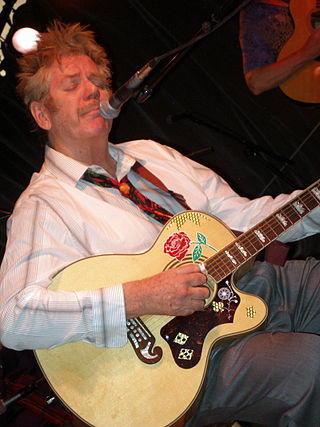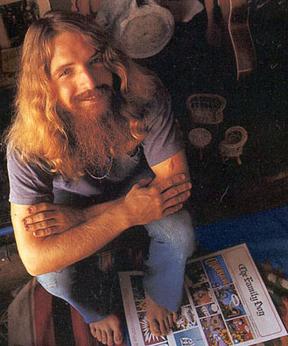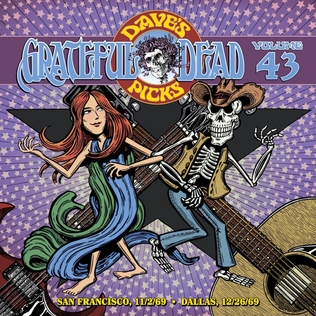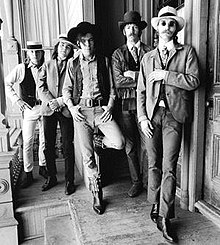
Psychedelic rock is a rock music genre that is inspired, influenced, or representative of psychedelic culture, which is centered on perception-altering hallucinogenic drugs. The music incorporated new electronic sound effects and recording techniques, extended instrumental solos, and improvisation. Many psychedelic groups differ in style, and the label is often applied spuriously.

A Hippie, also spelled hippy, especially in British English, is someone associated with the counterculture of the 1960s, originally a youth movement that began in the United States during or around 1964 and spread to different countries around the world. The word hippie came from hipster and was used to describe beatniks who moved into New York City's Greenwich Village, San Francisco's Haight-Ashbury district, and Chicago's Old Town community. The term hippie was used in print by San Francisco writer Michael Fallon, helping popularize use of the term in the media, although the tag was seen elsewhere earlier.

Flamin' Groovies is an American rock band that formed in San Francisco in 1965, originally co-led by Roy Loney and Cyril Jordan. After the Groovies released three albums, on Epic (Supersnazz) and Kama Sutra, Loney left the band in 1971. He was replaced as co-leader by Chris Wilson, and the band's emphasis shifted more toward British Invasion power pop.

Daniel Ivan Hicks was an American singer-songwriter and musician, and the leader of Dan Hicks and His Hot Licks. His idiosyncratic style combined elements of cowboy folk, jazz, country, swing, bluegrass, pop, and gypsy music. He is perhaps best known for the songs "I Scare Myself" and "Canned Music". His songs are frequently infused with humor, as evidenced by the title of his tune "How Can I Miss You When You Won't Go Away?" His album Live at Davies (2013) capped over forty years of music.

The Fillmore is a historic music venue in San Francisco, California.

Richard Alden "Rick" Griffin was an American artist and one of the leading designers of psychedelic posters in the 1960s. He was a key figure in the underground comix movement as a fouding member of the Zap Comix collective. Griffin was closely identified with the Grateful Dead, designing some of their best-known posters and album covers including Aoxomoxoa. His work within the surfing subculture included both film posters and his comic strip, Murphy.

NRBQ is an American rock band founded by Terry Adams (piano), Steve Ferguson (guitar) and Joey Spampinato (bass). Originally the "New Rhythm and Blues Quintet", the group was formed circa 1965. Adams disbanded it for a time, and the group re-formed in 1967. The quartet is known for its live performances, containing a high degree of spontaneity and levity, and blending rock, pop, jazz, blues and Tin Pan Alley styles. Its membership comprises the quartet of pianist Adams, bassist Casey McDonough, guitarist Scott Ligon, and drummer John Perrin. Some of the members in the band's long history are singer, writer and bassist Joey Spampinato, guitarists Al Anderson and Johnny Spampinato; drummers Tom Staley and Tom Ardolino; and vocalist Frank Gadler.
Blue Thumb Records was an American record label founded in 1968 by Bob Krasnow and former A&M Records executives Tommy LiPuma and Don Graham. Blue Thumb's last record was released in 1978. In 1995, the label was revived and remained active until 2005.
Chester Leo "Chet" Helms, often called the father of San Francisco's 1967 "Summer of Love," was a music promoter and a counterculture figure in San Francisco during its hippie period in the mid- to-late 1960s.
Sopwith Camel was an American rock band associated with the San Francisco psychedelic rock scene of the mid-1960s.
Stanley George Miller, better known as Mouse or Stanley Mouse, is an American artist who is notable for his 1960s psychedelic rock concert poster designs and album covers for the Grateful Dead, Journey, and other bands.
The Matrix was a nightclub in San Francisco from 1965 to 1972 and was one of the keys to what eventually became known as the "San Francisco sound" in rock music. Located at 3138 Fillmore Street, in a 100-capacity beer-and-pizza shop, The Matrix opened 13 August 1965, showcasing Jefferson Airplane, which singer Marty Balin had put together as the club's "house band". Balin had persuaded three limited partners to put up $3,000 apiece to finance the club's opening, giving them 75 percent ownership, while he retained 25 percent for creating and managing it.
Autumn Records was a 1960s San Francisco–based pop record label. Among the notable acts on its roster was The Beau Brummels, a band who released a pair of top 20 singles, "Laugh, Laugh" and "Just a Little".
Michael Ray Wilhelm was an American guitarist, singer and songwriter, best known as a founding member of the influential Bay Area band the Charlatans, who have been widely credited as starting the Haight-Ashbury psychedelic scene during the 1960s. He later played with the bands Loose Gravel and the Flamin' Groovies.

Erik Jacobsen is an American record producer, song publisher and artist manager. He is best known for his work in the 1960s with Tim Hardin, the Lovin' Spoonful, the Charlatans, and Sopwith Camel, and later with Norman Greenbaum, Tazmanian Devils and Chris Isaak. Retiring after forty years in the studio, he began working in video production. His first major video project was an auto-biographical webside, All About Erik, launched in 2019. His next, Erik's Travels, features his prize-winning travel documentaries, and was launched in 2024.

The Red Dog Saloon is a bar and live music venue located in Virginia City, Nevada. The bar played an important role in the history of the psychedelic music scene.

The Amazing Charlatans is a compilation album by the American psychedelic rock band the Charlatans that was released in 1996 by Big Beat Records. The album is a collection of demos, tracks that appeared on singles, and previously unreleased sessions that the band recorded between August 1965 and early 1968, at a variety of different San Francisco studios.

The Charlatans is the self-titled debut album by the San Francisco psychedelic rock band the Charlatans, and was released by Philips Records in 1969.

The Family Dog Denver was a concert dance hall located at 1601 West Evans Avenue in Denver, Colorado. Opened from September 1967 to July 1968, it is regarded as a seminal music venue that launched Denver on its trajectory to its current status as a major concert destination by introducing never-before-seen acts like The Doors, Van Morrison, Jimi Hendrix, Cream, Buffalo Springfield, Janis Joplin, Chuck Berry, and many others. Many acts, like The Doors and Van Morrison, for example, had yet to become famous when they played The Dog, evidenced by the poster artists having to stylize the names of their leading songs into the poster art for the shows. The Family Dog is also seen as a cultural turning point in Denver from the conservative, western-minded sensibility of the early and mid-20th century to the current, liberal-minded climate. The venue's history, surrounding drama and ultimate impact had been largely unknown and unrealized until it was unearthed and detailed for the first time in the 2021 documentary The Tale of the Dog, produced and directed by Dan Obarski & Scott Montgomery and distributed by Cinedigm. As there are no useful photos, no video and little written history remaining of the Family Dog Denver, the film's oral history format told in first person by the people who were there serves as a definitive reference for “The Dog.”

Dave's Picks Volume 43 is a three-CD live album by the rock band the Grateful Dead. It was recorded on November 2, 1969 at the Family Dog at the Great Highway in San Francisco, California, and on December 26, 1969 at McFarlin Memorial Auditorium in University Park, Texas. It was released on July 29, 2022, in a limited edition of 25,000 copies.













